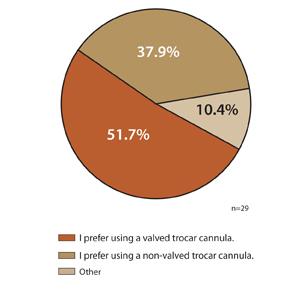OSN Retina 150
When accessing the ocular cavity for infusion of fluid or air during surgery, do you prefer to use a valved trocar cannula or a non-valved trocar cannula at the infusion connection?

![]()

Nikolas London
Valved cannulas maximize surgical safety and efficiency during small incision pars plana vitrectomy, and I prefer to use them whenever possible. They provide multiple benefits. Most importantly, they prevent rapid pressure fluctuations, which minimizes the risk of suprachoroidal hemorrhage; they help to prevent problems with subretinal perfluorocarbon liquid during retinal detachment repair; they are simpler to insert; and they eliminate certain steps during surgery such as clamping the infusion line after dyes are placed in the eye, as well as placing and removing cannula plugs. In my opinion, these benefits far outweigh the downsides of using valved cannulas, which include a relatively minimal cost and avoidable difficulty passing thin or flexible instruments. Moreover, if the valve ever becomes a hindrance, it can be cut away using the vitrector. I also prefer a valved cannula for the infusion port. While not as important as the other two cannulas, I like knowing that the eye will be stable if the infusion line is disconnected or turned off. Moreover, I also like to place all cannulas before connecting the infusion line, which would not be possible with a non-valved system.
– Nikolas London, MD
Disclosure: Dr. London has no relevant financial disclosures.
![]()

Carl D. Regillo
I now routinely use 23-gauge valved cannulas for all my pars plana vitrectomies. They effectively prevent intraoperative fluid, gas or oil leakage from the sclerotomies. Because all instruments pass through the valves very easily, there is really no downside to their routine use. They are particularly valuable in cases that have had prior vitrectomy and for working in eyes that have silicone oil. They save time by avoiding the use of plugs and help prevent relative intraoperative hypotony and associated problems such as choroidal detachment.
– Carl D. Regillo, MD
Disclosure: Dr. Regillo does research support and consulting for Alcon.
What size trocar do you use most?

